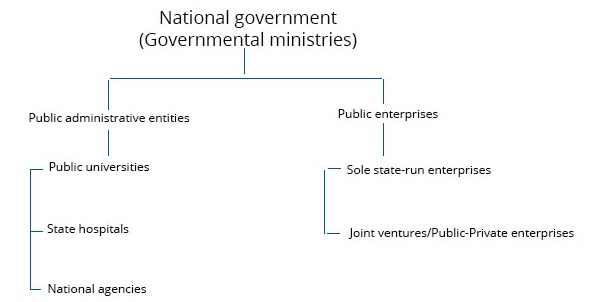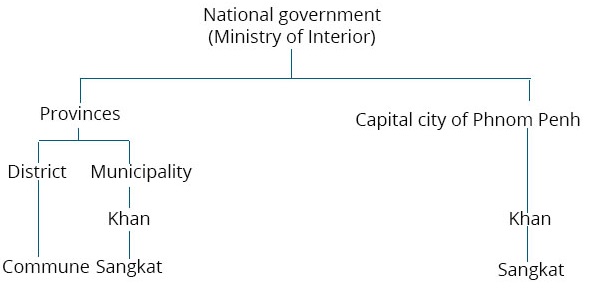National budget on uptrend
In the last three years, Cambodia’s national budget has seen significant growth of around US$ 1.6 billion, from US$ 3.4 billion in 20141 to US$ 5 billion in 2017.2 This is an average annual increase of almost 14%. The increase can be partly attributed to the country’s fast economy growth, typically around 7% or more annual GDP growth over several decades, and partly to the government’s efforts around tax collection. For this year, to meet the target state revenues, the Ministry of Economy and Finance, through the Customs Department and Tax Department, is committed to collect the equivalent of 8.29% and 7.74% of GDP respectively.3
People’s livelihoods: Impact of the national budget and its constraints
Every year, the Royal Government of Cambodia raises and spends billions of dollars. The money comes from a variety of sources such as tax and non-tax revenues, donor aid, and loans. In daily life, Cambodians pay value added tax (VAT) with purchases from gasoline to meals in restaurants, and pay income tax for salaries and dividends. However, people in general rarely raise questions about how the money is spent by the government, and in what ways the budget spending is having impacts on their livelihood.
The public investment on priority sectors to achieve the government’s national policies is expected to contribute to economy growth, poverty reduction and the improvement of people’s living conditions. However, despite significant poverty reduction from over 50% in 2004 to just around 13% in 2014,4 the World Bank cautioned that “most moved from being poor to being vulnerable,” meaning that only a small shock of US$ 0.30 per day would cause Cambodia’s poverty rate to double.5 What does it means if many of the 700,000 garment workers do not feel that they are better off after long hours of working per day but still have trouble in making end meet?6
All the information and related documents on the national budget are not available or transparent. While international donors have underlined concerns over the allocation of resources and transparency,7 the main opposition party has argued that the national budget contributes less to social programs, and the country’s dependency on foreign loans could be reduced through the promotion of the budget transparency.8 Despite the passing of the Law on Public Procurement in response to requirements from the World Bank and Asian Development Bank in 2012,9 bribery cases at Global Fund programs were found. The government’s two top health officers were reported as being involved in unfairly and illegally granting procurement contracts but no legal action was taken by either the Anti-Corruption Unit or officers of courts of law.10 Under a score for “irregular payments and bribes,” Cambodia was ranked very low at 114th place (out of 138 countries) in the Global Competitiveness Report 2016–2017.11 On the Global Competitiveness Index Cambodia was ranked 89th overall.12
Public debt situations in Cambodia
From 1993 to 2016, according to data from the Ministry of Economy and Finance, the Royal Government of Cambodia (RGC) signed concessional loan agreements with development partners amounting to US$ 8,309.81 million.13 The RGC has disbursed US$ 5,797.09 million, accounting for 69.76% of the total borrowing, of which 86.47 percent was poured into public infrastructure programs.14
According to statistics released by the Ministry of Economy and Finance, Cambodia’s concessional loans make a significant part of the national budget each year, with heavy reliance on bilateral rather than multi-lateral loans. From 2013 to 2016, bilateral concessional loans made up of 68% of the entire loans. Over a half of the total bilateral loans – US$ 2.12 billion – were borrowed from China. The Royal Government of Cambodia, especially the Ministry of Public Work and Transport, increasingly makes information on infrastructure projects available to the public, including country creditors and timelines of the projects, but not the loan figures and interest rates. However, (China) AidData, one of the open data organizations working on Chinese development finance, has been tracking China’s concessional loan projects to Cambodia. It has recorded interest rates applied variously from 1.25% up to 3%, depending on the project sectors and types of credit entities – Chinese government or state-run banks.15
Public procurement at national and sub-national levels
In Cambodia, the activities of buying goods, construction work, repairs, and services and consultation work by government, government ministries and agencies should be carried out in accordance with the Law on Public Procurement 2012. Procedures for a particular method of public procurement are prescribed in the Sub-Decree on Public Procurement 2006. The public procurement rules aim to ensure that state expenses are effectively and efficiently managed and controlled by transparent, fair and time-saving processes.
Diagram 1: Horizontal structure of the governmental ministries16
Public procurement can be carried out through various methods. They can be classified into:
- bids by international competition
- bids by domestic competition
- price consulting
- price surveys17
All procurement should go through one of these four methods. Included in the criteria of each method are the minimum prices of the bids, domestic resources (services and goods) involved and technical capacity.
The price for each method of public procurement may vary between the national and sub-national administration. The price of bids for international competition at the level of ministries, the capital city, provinces and public institutions should be from 5 billion riels, while the price of the bids for the same method is much lower at 2 billion riels for municipalities (Krong), districts (Srok) and Khan.18 The law bans any breakdown of the bidding price aiming to avoid the public procurement process, with conditions of penalties.19
Diagram 2: Structure of Cambodia’s sub-national administration
Procurement implementing bodies in the different institutions should make information on bids available to the public.20 Since February 2011, information on bids by international competition and bids by domestic competition has been made available on MEF’s website (goods, construction, services, and consulting services). Announcements of bids under districts, and commune/Sangkat projects can be found at the National Committee for Sub-National Democratic Development (NCDD) and One Window Service websites. These announcements can also be found at other governmental ministries such as Ministry of Education Youth and Sport (MoEYS), and Ministry of Public Work and Transport websites.
Last update: 24 April 2017
References
- 1. Vong Sokheng. “Budget passes sans opposition.” The Phnom Penh Post, 12 November 2013. Accessed 23 April 2017. https://www.phnompenhpost.com/national/budget-passes-sans-opposition
- 2. May Kunmakara. “Budget for 2017 to increase by $5 Bil.” The Khmer Times, 20 October 2016. Accessed 23 April 2017. https://www.khmertimeskh.com/61388/budget-for-2017-to-increase-by-5-bil/
- 3. Hor Kimsay. “Budget to swell with economy 2017: gov’t official.” The Phnom Penh Post, 15 June 2016. Accessed 23 April 2017. https://www.phnompenhpost.com/business/budget-swell-economy-2017-govt-official
- 4. Logan Connor. “World Bank expert on whether Cambodia will maintain its impressive growth.” Southeast Asia Globe, 10 March 2017. Accessed 23 April 2017. https://southeastasiaglobe.com/world-bank-expert-on-whether-cambodia-will-maintain-its-impressive-growth/
- 5. Carlos Sobrado, Samsen Neak at al. Where have all the poor gone? Cambodia poverty assessment 2013. A World Bank country study (ACS4545). 2nd Edition. Washington, D.C. : World Bank, April 2014. http://documents.worldbank.org/curated/en/824341468017405577/pdf/ACS45450REVISE00English0260May02014.pdf
- 6. Ate Hoekstra. “Cambodian garment workers stay poor while dressing the West.” DW, 3 March 2017. Accessed 23 April 2017. http://www.dw.com/en/cambodian-garment-workers-stay-poor-while-dressing-the-west/a-37796952
- 7. Tej Parkh and Kang Sothea. “Lack of Transparency Hinders Budget Progress.” The Cambodia Daily, 26 March 2016. Accessed 23 April 2017. https://www.cambodiadaily.com/archives/lack-of-transparency-hinders-budget-progress-110437/
- 8. Hor Kimsay. “Budget to swell with economy 2017: gov’t official.” The Phnom Penh Post, 15 June 2016. Accessed 23 April 2017. https://www.phnompenhpost.com/business/budget-swell-economy-2017-govt-official
- 9. Chan Muyhong. “ACU to police public tender process.” The Phnom Penh Post, 23 December 2014. Accessed 23 April 2017. https://www.phnompenhpost.com/business/acu-police-public-tender-process
- 10. Meas Sokchea. “CNRP eyes health checkup.” The Phnom Penh Post, 7 December 2016. Accessed 23 April 2017. http://www.phnompenhpost.com/national/cnrp-eyes-health-checkup
- 11. World Economic Forum. “Global Competitiveness Index: Competitiveness rankings.” Accessed 23 April 2017. http://reports.weforum.org/global-competitiveness-index/competitiveness-rankings/#series=BRIBEIDX
- 12. World Economic Forum. “Global Competiveness Index: Economy profiles, Cambodia.” Accessed 23 April 2017. http://reports.weforum.org/global-competitiveness-index/country-profiles/#economy=KHM
- 13. Ministry of Economy and Finance. Cambodia Public Debt Statistical Bulletin. Vol.3, March 2017. http://www.mef.gov.kh/documents/shares/publication/public-debt-bulletin/Cambodia-Public-Debt%20Statistical-Bulletin-Vol-3.pdf
- 14. Ibid.
- 15. AidData. “Data: Search projects.” Accessed 22 April 2017. http://china.aiddata.org/
- 16. Lists of public administrative entities and public enterprises have been collected and prepared by Public Financial Management reform program. Ministry of Economy and Finance (MEF). Public Financial Management (PFM) Reform Program: PFM Evaluation in Cambodia. 2nd Draft, 8 September 2015. Accessed 22 April 2017. http://pfm.gov.kh/Document/workshop/20151021/pefa_assessment_draft.pdf
- 17. Sub-decree No. 105 on Public Procurement (18 October 2006), article 8.
- 18. Proclamation No. 1866 on Definite Sums for Implementation of Procurement Methods (26 December 2014).
- 19. Law on Public Procurement (2012), article 33.
- 20. Law on Public Procurement (2012), article 38.



